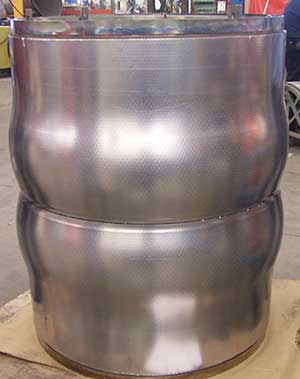GKN Aerospace has developed a new manufacturing process called delta pressure forming that will form compound curves into titanium structures.
The company is already using the new process to manufacture the cone-shaped titanium exhaust system for the Boeing 747-800.
The technique will also provide an effective method to create the complex shapes required for rugged items such as engine inlet lips and inner barrels, thrust reverser inner fixed structures and exhaust nozzles and plugs.
In the past, the company has produced flat panels of titanium honeycomb sandwiches using etablished resistance welding and diffusion bonded techniques. Until now, however, these panels have been formed to the shape of the final product using drape creep forming.
In this process, the flat panel is draped around a die in a vacuum furnace at temperatures well above 1000°F, with static weights attached to the ends of the panel. This creates a straight cylindrical or conical shape.
Delta pressure forming starts with a cylindrical honeycomb barrel which has already been formed in a process that employs a roller system in place of the static weights. The cylindrical barrel is then inflated in a die to create the required compound curvature.
The operation is conducted in a vacuum furnace at temperatures exceeding 1500°F and the inflation pressure is provided by inert argon gas. Special tooling ensure that the honeycomb core and the face sheets are not damaged during the process.

Trial plug made using the delta pressure forming process
'Our new "delta pressure forming" process complements our existing titanium manufacturing capability, allowing us to bring the benefits of this metal to a great many more severe environments,' said Marcus Bryson, chief executive officer of GKN Aerospace.




Plasma technique converts landfill methane to jet fuel
Trevor; there are still many landfill sites in the UK where the methane is not captured but not only that, where there is protein waste in them, they...